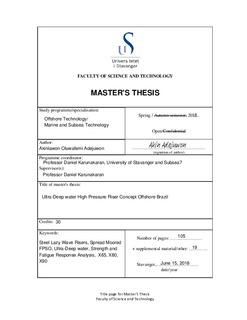| dc.description.abstract | Since the 1950s, risers have continued to be an important part of an oil and gas producing field. As the primary equipment that conveys fluids to and from the topside vessel, it is important that a riser is designed to withstand all conditions it will be subjected to during its lifetime. With hydrocarbon exploration activities moving into ultra-deep water, research related to the structural integrity of a riser deployed in ultra-deep water has become necessary.
The ultra-deep water region considered in this thesis work is the Santos Basin located about 300 km offshore Brazil. The Santos Basin is a benign environment that is not characterized by hurricanes, typhoons or extreme weather conditions. However, oil producing activities in this region would require a vessel that has storage capabilities due to the distance the region is from shore. With this requirement in mind, different floaters were evaluated and a spread-moored Floating Production, Storage and Offloading (FPSO) vessel was selected for this thesis work.
The selection of the spread-moored FPSO presented a new challenge; high motion sensitivity. Since FPSOs are high motion vessels, risers connected to them will experience fatigue damage in their touchdown zone. However, after evaluation of different riser concepts, the Steel Lazy Wave Riser (SLWR) was selected because it has the ability to decouple its touchdown zone from vessel motions due to the presence of buoyancy modules fitted along the lower section of the riser.
With the selection of spread-moored FPSO and a SLWR, material selection for the SLWR was carried out. For ultra-deep water deployment, a riser’s material should posses ultra-high strength, good weldability, high collapse resistance, high operating pressure and excellent low-temperature toughness. These material properties are found in the API 5L X65,X80 and X90 carbon steel grade material. Hence, they were the selected material used for the SLWRs in this thesis work. Dynamic and fatigue response analysis was conducted on the SLWRs made of each material and it was observed that all the three materials met the requirements of the DNV-OS-F201 reference standard with the X65 riser having the worst dynamic response, followed by the X80 riser, followed by the X90 riser.
Also in past SLWR deployments with spread-moored FPSOs, risers were usually connected to hang-off points along the port side of the vessel. In this thesis work the SLWRs were connected to hang-off points both along the port side of the vessel and along the middle of the vessel. The purpose of doing this was to investigate if buoyancy can be saved by connecting a riser along the middle of the vessel rather than the along the port side. From the results of the investigation, it was observed that about 7.5% of buoyancy could be saved by connecting a riser to the middle of the vessel rather than to the port side of the vessel. In addition, it was observed that risers connected to the middle of the vessel showed an increase of at least 246% in the minimum fatigue life observed.
Overall, all the riser materials considered in this study all meet the dynamic and fatigue response criteria. Therefore, further work should be carried out as given in the recommendations of this thesis work to select the most suitable material for deployment in the ultra-deep water region of the Santos Basin, offshore Brazil. | nb_NO |
